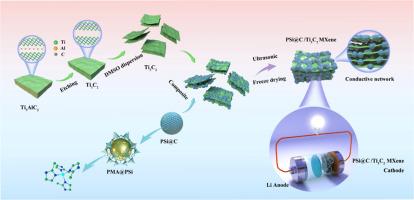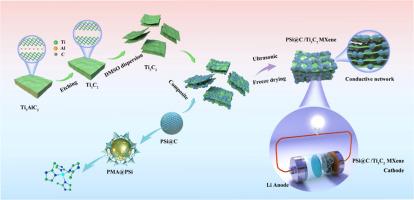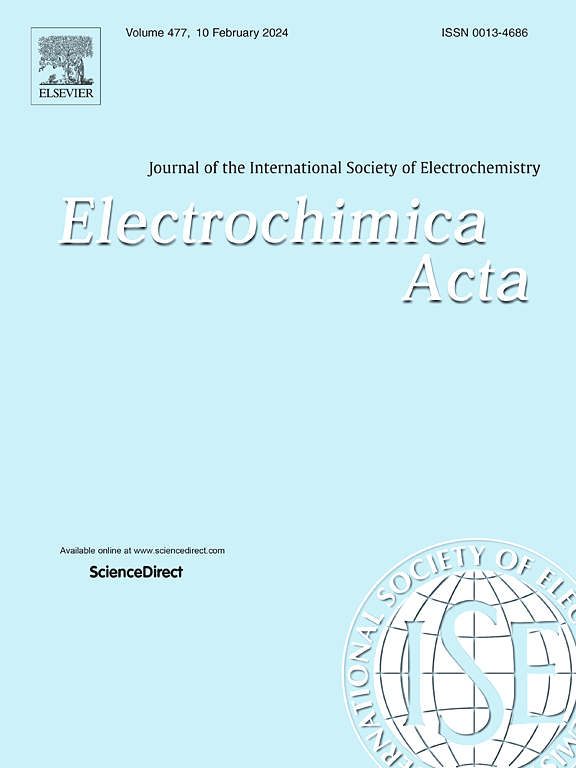将 Ti3C2 MXene 作为导电夹层用于提高 PSi@C 阳极材料储锂性能的结构设计与研究
IF 5.5
3区 材料科学
Q1 ELECTROCHEMISTRY
引用次数: 0
摘要
硅资源丰富,锂化/退锂电位低,比容量高,是下一代锂离子电池(LIB)的理想负极材料。然而,其实际应用却因体积膨胀过大而受到阻碍,导致电极结构损坏。本研究利用超声波将多孔微硅@碳(PSi@C)颗粒分散到可分层堆叠的 Ti3C2 MXene 片材中,然后进行冷冻干燥,开发出多孔硅(PSi)@C/Ti3C2 MXene 复合材料。Ti3C2 MXene 中间层在增强 PSi@C 颗粒之间的导电交联网络以及为电子传输/离子扩散提供有效通道方面发挥了关键作用。此外,Ti3C2 MXene 中间膜还起到缓冲作用,以适应电化学循环过程中硅体积的大幅变化。因此,PSi@C/Ti3C2 MXene 复合电极既能快速传导电子/离子,又能保持结构的稳定性。值得注意的是,该电极表现出了出色的长周期稳定性,在循环 200 次后,0.5 A g-1 时的电量为 952 mAh g-1,在 2 A g-1 时的电量为 542 mAh g-1。本文章由计算机程序翻译,如有差异,请以英文原文为准。


Structural design and investigation of Ti3C2 MXene as a conductive interlayer for improving the lithium-storage performance of PSi@C anode material
Silicon stands out as an ideal anode material for the next generation of lithium-ion batteries (LIBs) due to its abundant sources, low lithiation/delithiation potential, and high specific capacity. However, its practical application is impeded by significant volume expansion, leading to electrode structure damage. In this study, the Porous silicon(PSi)@C/Ti3C2 MXene composite was developed by dispersing porous micro-silicon@carbon (PSi@C) particles into layered stackable Ti3C2 MXene sheets using ultrasonic and freeze drying. The Ti3C2 MXene interlayer played a crucial role in enhancing the conductive crosslinking network between PSi@C particles, and providing efficient channels for electron transport/ion diffusion. Additionally, the Ti3C2 MXene interlayer served as a buffer to accommodate the substantial volume changes in silicon during electrochemical cycling. Consequently, the PSi@C/Ti3C2 MXene composite electrode demonstrated rapid electron/ion conduction and maintained structural stability. Remarkably, the electrode exhibited outstanding long cycle stability with 952 mAh g-1 at 0.5 A g-1 after 200 cycles and excellent rate performance with 542 mAh g-1 at 2 A g-1.
求助全文
通过发布文献求助,成功后即可免费获取论文全文。
去求助
来源期刊

Electrochimica Acta
工程技术-电化学
CiteScore
11.30
自引率
6.10%
发文量
1634
审稿时长
41 days
期刊介绍:
Electrochimica Acta is an international journal. It is intended for the publication of both original work and reviews in the field of electrochemistry. Electrochemistry should be interpreted to mean any of the research fields covered by the Divisions of the International Society of Electrochemistry listed below, as well as emerging scientific domains covered by ISE New Topics Committee.
 求助内容:
求助内容: 应助结果提醒方式:
应助结果提醒方式:


